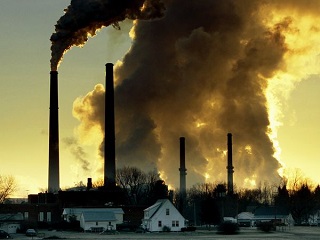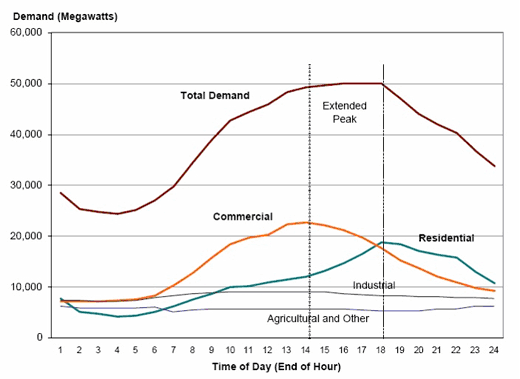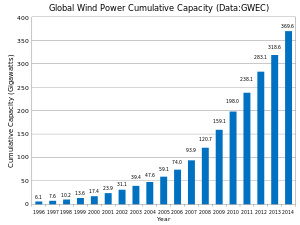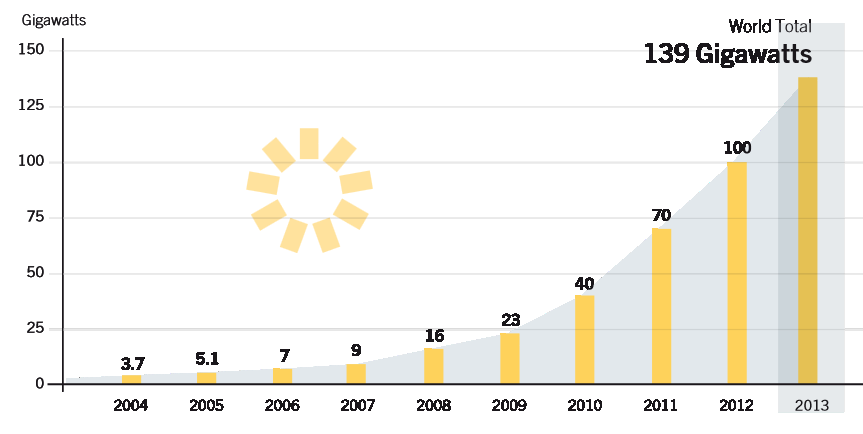The Economic Validity of Solar and Wind Power

1: Power Storage Is Incredibly Expensive On a Large Scale
This is true, at least at this point, but it’s not a huge impediment to the adoption of solar and wind. The fact that the resources are variable doesn’t mean that they’re worthless. Wind is about 5% of the U.S. grid mix today, and growing steadily. This figure can (and will) triple before storage becomes a critical consideration, even if we still have no way to distribute that much power with transmission or synthetic fuels. Storage of solar energy is fairly unimportant because of the confluence of the sun in the sky and the demand for energy.
This a good place to raise an important point: To say something is expensive makes the reader wonder: Expensive compared to what? Insofar as renewables are in the process of replacing fossil fuels like coal, it is important to note that burning coal causes smog, soot, acid rain, global warming, and toxic air emissions; it generates waste including ash, sludge, toxic chemicals, and waste heat creating more environmental problems. Mining, transporting, and storing coal levels mountains and pollutes the land, water, and air. Coal plants need billions of gallons of cooling water and harm wildlife.
Coal’s high greenhouse gas emissions (CO2 and CH4) are nothing in comparison to its oxides of nitrogen and sulfur, its heavy metals: mercury, cadmium, selenium, arsenic, and its amazing array of radioactive isotopes.
The Harvard Medical School estimates that the cost of burning coal in the healthcare sector alone, i.e., dealing with the lung disease caused by breathing the aromatics of coal, was approximately $750 billion last year, a period of time in which over a million people died (13,000+ in the U.S.) and many millions were stricken with diseases.
Not a nickel of this money nor a bit of the human misery associated with it is absorbed in the operating ledger of the coal-burning utilities or their customers; the costs are simply passed on to society at large, especially to the infirmed and the relatives of the dead. Economists refer to this as an “externality.”
Now, realize that healthcare is only one of many such externalities, that, in fact, the totality of the long-term environmental damage is far larger than a measly three-quarter trillion dollars.
More on this subject is presented below, but now let’s return to the author’s eleven assertions.
2: The U.S. Power Grid Is Older, And Has Trouble Handling Solar And Wind
There is no doubt that our ailing infrastructure, of which our power grid is a part, is in dire need of an upgrade. In particular, that “upgrade” will contemplate the 21st energy concept that two-way communication is necessary, i.e., from the utility to the customer and vice versa. Will this be expensive? Yes. Is it avoidable? No.
Note also that, for the moment, integrating incrementally more variable resources into the grid at this point isn’t a huge problem. This won’t be true at higher penetration rates, but realize that no one (with any sense) is expecting solar and wind to power the world by themselves. This is discussed further below.
Also, note that solar and wind are expanding year after year. This isn’t an opinion; it’s a fact. The author seems to be arguing that solar and wind can’t work in the context of expansion curves like this:
3: Rebuilding The Power Grid To Handle Solar And Wind Is Absurdly Expensive
In addition to the answer immediately above: While it’s true that solar and wind will benefit from an improved power grid, our infrastructure needs a great deal of upgrading regardless of the presence of renewable resources.
Again, I would ask the author to define “absurdly expensive.” In the absence of a change in our civilization’s approach to energy, our scientists are almost completely certain that we will experience catastrophic climate change, ocean acidification, and enormous loss of biodiverisity. The world’s love of oil and the US allied position to Saudi Arabia is also fueling ISIS and other terrorists. The continuation of our current energy policy really is “absurdly expensive” by any definition.
4: Solar and Wind Don’t Provide Power At Useful Times

Human activity continues when the sun goes down. Overall, there is a good correlation between solar power and demand, but a poor one for wind. Here’s a chart that shows that “extended peak” and presents the demand by hour.
5: Solar And Wind Can’t Keep the Lights On By Themselves
Again, the idea of powering the world with 100% solar and wind is moot; no one with any understanding of the energy issue is suggesting that this is a good idea, at least for the foreseeable future.
Having said that, the assertion as it’s stated isn’t true. Solar and wind actually could perform this feat if we didn’t care how much we paid for it, but considering that we do, we need to acknowledge that powering the entire Earth with nothing other than solar and wind would cost hundreds of times more than the process we see slowly and smoothly taking place around us.
Note the use of the present tense; yes, it’s happening as you read these words. We are integrating these variable resources with the other types of renewables, energy efficiency, storage (as the price continues to fall), smart-grid, and electric transportation. We’ll be thrilled to have advanced nuclear when it comes along. Natural gas will remain important indefinitely however, eventually to be used primarily as a backup to non-fossil resources.
6: The Best Places For Solar And Wind Are Usually Far Away From Consumers
Again, this is partially true. It’s certainly true that no one wants to live where the wind blows its hardest. This, however, makes those places ideally suited for wind turbines, a sight that some people don’t want in the backyard vistas.
This is not the case with solar, however. The deserts have a lot of sun, but all that heat is not good for the efficiency of PV, and the best sites are in the temperate climates where large populations have settled.
7: Solar And Wind Are a Very Small Percentage Of The Power Grid Despite Years of Subsidies
True (though the source the author cites conflates “energy” with “electricity”). Wind is just under 5% of the US electricity grid mix. But consider for a minute what that means. The amount of installed wind, growing each year offsets coal, at least partially. Each of the 572 coal plants in the U.S. burns an average of 1.4 million tons of coal per year, and wind is offsetting more of that every year. As discussed above, these are extremely important issues to all of us with children (not to mention lungs).
8: The Solar And Wind “Low-Hanging Fruit” Have Already Been Taken – “green” power sources are difficult to expand and are simply not practical in some areas.
I’m sure this is true in a few places. Putting it charitably, this is an extremely minor consideration to the overall adoption curve of solar and wind.
9: Natural Gas Prices Are Very Low In The United States
True. Natural gas (thankfully) will be with us for a long time to come, insofar as it’s needed as a backup for other greener energy sources.
Those of us who study the subject objectively advocate for an energy policy that phases out the most objectionable forms of fossil fuels (coal for electricity, oil for transportation) as soon as possible, and leaves natural gas to play an important role for many decades hence.
10: Nuclear Energy Has Enormous Potential
True. God bless it. Bring it on. There isn’t one decent, caring person on this planet who isn’t rooting for “advanced nuclear.” Yet today, nuclear is extremely expensive, and we’re at least 30 years and untold fortunes away from the commercialization of the new nuclear technologies that the author mentions.
11: Encouraging Wind And Solar Creates Incentives For Massive Corruption
Yes, there has been, and will continue to be, corruption associated with the clean energy industry. But if the author wants to see corruption in all its glory, he need only examine the source of campaign contributions to the current U.S. Congressmen from the fossil fuel industry, a group that employs more lobbyists than any other. At the same time, he should ask himself why the U.S. taxpayers are continuing to write subsidy checks for tens of billions of dollars per year to the oil companies, 90 years after their inception, long after they have become by far the wealthiest, most powerful industry in the history of humankind.
Summary:
A few more words on costs, as economics really is the mother discipline. As a friend of mine likes to say, “If you don’t care how much you pay for it, I’ll generate all the clean energy you could every possibly use.” If this were an honest presentation of the validity of solar and wind, the author would have noted:
• Huge companies like Walmart are in the process of pulling themselves off the grid entirely, having noticed that they can generate electricity with solar (and store what they can’t use immediately) less expensively than they can buy it from their power utilities.
• Though the cost of solar wind are falling fast, the levelized cost of energy from these sources is still higher than that of coal, our cheapest and deadliest source. But the cost of a technology still in its infancy is not completely relevant. If this were the only criterion used to establish the validity of an industry, we’d still have a very primitive culture indeed; certainly we’d have no cars, planes, wonder drugs or electronics of any kind. (Can you imagine what it cost to build the first computer or send the first rocket into space?)
• The article doesn’t deal with the most obvious feature of solar and wind, i.e., that in the real world, they’re growing like weeds. Google “renewable energy (name of bank),” and plug in the huge investment banks like Goldman Sachs, Credit Suisse, and Deutsche Bank, then a few retail banks like Wells Fargo. You’ll see that most of them have entire business practices in this space, and are in the process of investing trillions of dollars into this juggernaut. Note the title of the article linked above: “Credit Suisse Projects ~85% Of US Energy Demand Growth Coming From Renewables Through 2025.” Arguing that solar and wind can’t work is like claiming that airplanes made of steel are too heavy to fly.
There isn’t the remotest bit of academic integrity in this piece. It’s actually, at some level, a parody of itself. How much stupidity does the author impute to his readers? Does he think the common American really sees this whole issue in terms of black and white? As a country, I’ll admit that we may be somewhat ignorant on matters like these, but there is a limit to our ignorance, and the author has crossed it in a big way.



Regarding 7
:Solar And Wind Are a Very Small Percentage Of The Power Grid Despite Years of Subsidies
This may be true in the US, but there are countries where they deliver a far larger proportion of the electricity supply.
Denmark generated 39% of its electricity using wind power in 2014 with plans to rise to 50% in the near future.
Italy now receives just under 10% of its electricity from solar.